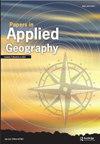Spatial Planning Framework for Development of Rural Activity Centers: Method of Location Allocation, Effect on Trip Length, and Policy Implications
Q2 Social Sciences
引用次数: 3
Abstract
Abstract Activity center (AC) location allocation is a central concept for better quality of life, poverty reduction, accessibility maximization, and minimization of trip length and cost. An AC is characterized by p number of basic facilities present within it. The proposed framework identifies heuristically the potential locations of ACs that consist of multiple basic facilities. This article proposes a spatial planning framework to help policymakers while making infrastructure development decisions within budgetary limitations. For the application of this planning framework, a rural district in India is considered to allocate the location of ACs with four facilities: a health-care center, high school, bank, and market. The effect of AC developments on trip length is analyzed by preparing different activity chains to complete multiple trip purposes. Two cases are considered for location allocation of ACs. In the first case, we assumed that there is no facility existing in the study area; the latter case dealt with a situation where there are facilities already existing. In the case analysis, four categories of ACs are configured: AC4 with all four facility types, AC3 with any three facility types, AC2 with any two facility types, and AC1 with a single facility. Findings revealed that considerable trip cost savings in terms of trip length reduction could be realized from AC4 type activity centers over all other categories of AC. The policy context discussed in this article will not only help in maintaining uniformity in socioeconomic services over the region, but also, balance population density in physically isolated areas and densely populated areas. With the illustrated application, all the identified ACs with partial services within a region can be augmented to become full-fledged ACs in a phased manner, where infrastructure financing is constrained, particularly in lower and middle-income economies. In summary, the research framework will improve the quality of life in rural regions with a focus on better health, improved education, and an enhanced economy.农村活动中心发展的空间规划框架:区位分配方法、对出行长度的影响及政策启示
活动中心(AC)的位置分配是提高生活质量、减少贫困、最大化可达性、最小化行程长度和成本的核心概念。AC的特征是其中存在p个基本设施。建议的框架启发式地确定由多个基本设施组成的ACs的潜在位置。本文提出了一个空间规划框架,以帮助决策者在预算限制下做出基础设施发展决策。为了应用这一规划框架,考虑在印度的一个农村地区分配具有四种设施的社区:保健中心、高中、银行和市场。通过准备不同的活动链来完成多个行程目的,分析了交流发展对行程长度的影响。考虑了两种情况来分配ac的位置。在第一种情况下,我们假设研究区域内不存在设施;后一种情况处理的是已有设施的情况。在案例分析中,配置了四种类型的ac: AC4具有所有四种设施类型,AC3具有任意三种设施类型,AC2具有任意两种设施类型,AC1具有单一设施类型。研究结果表明,相对于所有其他类型的AC, AC4类型的活动中心在减少行程长度方面可以实现相当大的旅行成本节约。本文讨论的政策背景不仅有助于保持该地区社会经济服务的一致性,而且还有助于平衡地理隔离地区和人口稠密地区的人口密度。在基础设施融资受限的地区,特别是在中低收入经济体,通过上述应用程序,可以分阶段将一个地区内所有具有部分服务的已确定的ac扩大为成熟的ac。总之,研究框架将改善农村地区的生活质量,重点是改善健康、改善教育和促进经济。
本文章由计算机程序翻译,如有差异,请以英文原文为准。
求助全文
约1分钟内获得全文
求助全文

 求助内容:
求助内容: 应助结果提醒方式:
应助结果提醒方式:


